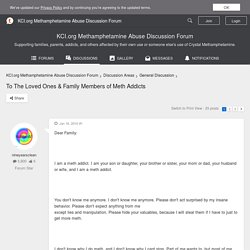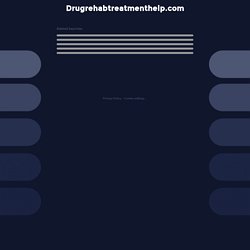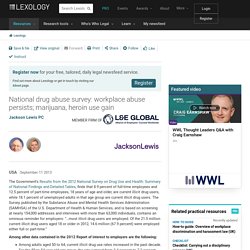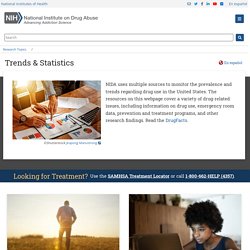

National Survey on Drug Use and Health (NSDUH) 15 Maps That Show How Americans Use Drugs. Revisiting Employee Assistance Programs and Substance Use Problems in the Workplace: Key Issues and a Research Agenda. Evidence for the effectivness and cost-effectiveness of interventions to reduce alcohol-related harm - E92823. Microsoft Word - cover_0619.doc - 2008_WISM.pdf. To The Loved Ones & Family Members of Meth Addicts in General Discussion Forum. Dear Family: I am a meth addict.

I am your son or daughter, your brother or sister, your mom or dad, your husband or wife, and I am a meth addict. You don't know me anymore. I don't know me anymore. Please don't act surprised by my insane behavior. I don't know why I do meth, and I don't know why I cant stop. I know I'm supposed to love you, but right now the only thing I am capable of loving is meth.
I would die for meth. I know you don't understand it, and neither do I, but it is where I am at right now and I don't know how change it, or if I even want to. I am sick and tired, but I cannot stop. As long as you keep believing my lies, I will use you to get what I need, and what I need is meth, and only meth. How to Help an Addict: TED TALK 3 - Drug Rehab and Alcohol Treatment.
Speaker: Itay Talgam Topic: Itay Talgam’s TED bio says the conductor and organization behavior analyst “[Imagines] music as a model for all spheres of human creativity, from the classroom to the boardroom.”

Talgam’s TED talk looks at different conductors, their leadership styles in conducting symphonies, and how each conductor’s approach impacts the cohesiveness and capabilities of the musicians. Talgam’s talk is significant on multiple levels and relates to many facets of our lives. Drug Abuse Recognition Training. Drug Tests for Job Applicants: If You're Asked to Take a Drug Test. Many employers require job applicants to take a drug test -- particularly those applicants who reach the final stages of the selection process.

Why is employment drug testing so common? Do applicants have to agree to take the test? And do applicants have any legal rights in the process? This article explains the rules on applicant drug testing. Why Employers Drug Test Most private employers are not required to test for alcohol or drug use. So if it's not usually required, why do employers drug test? To qualify for workers' compensation discounts. Legal Limits on Drug Testing Courts and legislators have recognized that drug testing implicates privacy rights. Because drug testing is intrusive, state and federal laws put some limits on when, how, and whether it can be done. National drug abuse survey: workplace abuse persists; marijuana, heroin use gain. The Government’s Results from the 2012 National Survey on Drug Use and Health: Summary of National Findings and Detailed Tables, finds that 8.9 percent of full-time employees and 12.5 percent of part-time employees, 18 years of age and older, are current illicit drug users, while 18.1 percent of unemployed adults in that age group are current illicit drug users.

The Survey, published by the Substance Abuse and Mental Health Services Administration (SAMHSA) of the U.S. Department of Health & Human Services, and is based on screening at nearly 154,000 addresses and interviews with more than 63,000 individuals, contains an ominous reminder for employers: “…most illicit drug users are employed. Of the 21.5 million current illicit drug users aged 18 or older in 2012, 14.6 million (67.9 percent) were employed either full or part-time.” Among other data contained in the 2012 Report of interest to employers are the following: Certain assumptions also may have to be questioned. Trends & Statistics. Brief Description There are a variety of sources of information NIDA uses to monitor the prevalence and trends regarding drug abuse in the United States.

The resources below cover a variety of drug related issues, including information on drug usage, emergency room data, prevention and treatment programs, and other research findings. Costs of Substance Abuse Abuse of tobacco, alcohol, and illicit drugs is costly to our Nation, exacting more than $700 billion annually in costs related to crime, lost work productivity and health care. Treatment Statistics. According to the Substance Abuse and Mental Health Services Administration’s (SAMHSA’s) National Survey on Drug Use and Health,1 23.5 million persons aged 12 or older needed treatment for an illicit drug or alcohol abuse problem in 2009 (9.3 percent of persons aged 12 or older). Of these, only 2.6 million—11.2 percent of those who needed treatment—received it at a specialty facility. SAMHSA also reports characteristics of admissions and discharges from substance abuse treatment facilities* in its Treatment Episode Data Set2 (TEDS). According to TEDS, there were 1.8 million admissions in 2008 for treatment of alcohol and drug abuse to facilities that report to State administrative data systems.
Most treatment admissions (41.4 percent) involved alcohol abuse. Heroin and other opiates accounted for the largest percentage of drug-related admissions (20.0 percent), followed by marijuana (17.0 percent). Other Information Sources Data Sources Notes. Drug Test Congress.